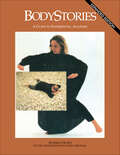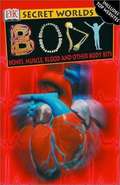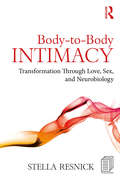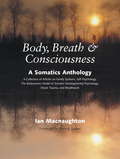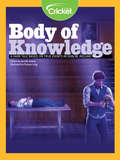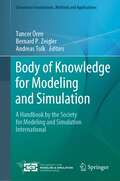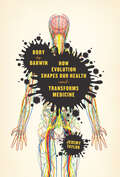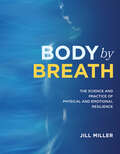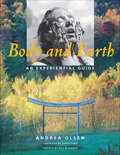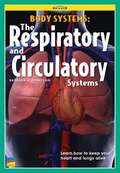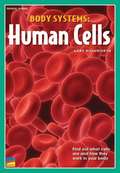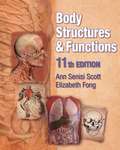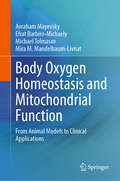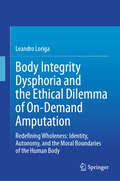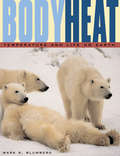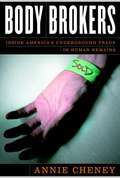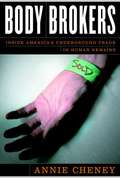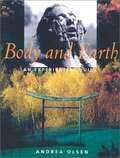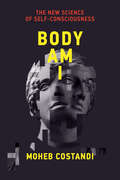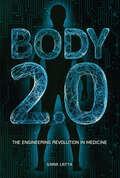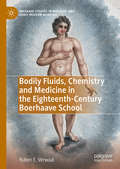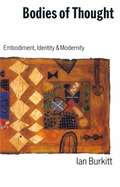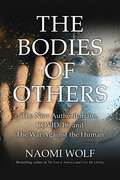- Table View
- List View
BodyStories: A Guide to Experiential Anatomy
by Andrea Olsen Caryn McHoseBodyStories is a book that engages the general reader as well as the serious student of anatomy. Thirty-one days of learning sessions heighten awareness about each bone and body system and provide self-guided studies. The book draws on Ms. Olsen's thirty years as a dancer and teacher of anatomy to show how our attitudes and approaches to our body affect us day to day. Amusing and insightful personal stories enliven the text and provide ways of working with the body for efficiency and for healing. BodyStories is used as a primary text in college dance departments, massage schools, and yoga training programs internationally.
Body: Bones, Muscle, Blood and Other Body Bits
by Richard Walker Jayne ParsonsIt's a weird world out there. . . dazzle your friends with wacky facts and more from this mega new series. Did you know. . . The smallest bone in your body, the stirrup bone, lives deep inside your ear. A sneeze can burst through your nostrils at an astonishing 160 mph. A nerve impulse takes on hundredth of a second to travel from your big toe to your spinal cord. A full-color, fun, and informative series, Secret Worlds offers a chance to get your teeth deep into a wide range of fascinating subjects from nature, history, and science. Every title has: Easy-to-read narrative text written by a specialist who combines expert knowledge with an entertaining and fresh style. Superb color photography that entices the reader into the subject world with close-up views and dramatic shots. Weird World feature boxes that reveal a wealth of wacky facts. Tried-and-tested websites to check out the latest info. A mega reference section with even more facts and figures for the enthusiast. Suitable for children aged ten and up -- as well as every other family member who is curious about the subject.
Body-to-Body Intimacy: Transformation Through Love, Sex, and Neurobiology
by Stella ResnickThis book presents an integrative, growth-oriented approach to therapy with couples that demonstrates the dynamic interplay between partners’ emotional issues and their sexual difficulties. It offers a model for relational and sexual enhancement that focuses as much on partners’ present, nonverbal body-to-body communications as on their words. Dr. Stella Resnick draws on research from interpersonal neurobiology, sexology, positive psychology, and Gestalt therapy, and shares a rich assortment of therapy vignettes to demonstrate the transformative power of pleasure and how a focus on body-to-body intimacy can heal emotional wounds from the past and encourage greater presence, empathy, authenticity, playfulness, and sexual pleasure between intimate partners. The therapeutic process is explored in four related spectrums: the Problem-Transformation Spectrum, the Attachment-Sexuality Spectrum, the Pain-Pleasure Spectrum, and the Cognitive-Somatic-Experiential-Behavioral-Spectrum. Part I lays the theoretical foundation for the work. Part II examines the early attachment bond between parent and child and its effects on adult capacity for emotional closeness and sexual pleasure. Part III offers methods for resolving painful emotional issues underlying many sexual difficulties. Finally, Part IV describes the procedure for moving from a cognitive reframing of the problem to a somatic focus on the body and tracking present-moment emotional interactions to the repair of relational injuries that nurture transformational change. Also included is a series of process-oriented exercises and a handout that therapists can use in their own practice. Body-to-Body Intimacy will enable couples and sex therapists to expand their practices and enrich their clients’ sexual and relational dynamics. This book also contains valuable information that will be appreciated by anyone interested in a greater understanding of a growth-oriented therapeutic process for couples and what can be achieved together by gaining a deeply loving and sexually fulfilling intimate love relationship.
Body, Breath, and Consciousness
by Peter A. Levine Ian MacnaughtonThe forces that develop the self--somatic, emotional, mental, interpersonal, social, and spiritual--must all be considered by therapists in treating any patient. Each article in this important anthology deals in some way with these various elements. The writing is focused on the body-mind connection, exploring the practices and theories of this popular branch of psychology. Topics include the significance of family systems; dealing with trauma and shock in therapy; and the importance of breathing, offering valuable insights for the student and practitioner alike. Contributors include Marianne Bentzen, a trainer in Somatic Developmental Psychology; Peter Bernhardt, a professor of psychology; and Peter A. Levine, author of Waking the Tiger.
Body of Knowledge: A Dark Tale Based on True Events in Dublin, Ireland
by Jennifer MasonTake a daunting journey into the "dissection theater." This fictional story will give you chills and thrills while presenting you with a plausible moral dilemma.
Body of Knowledge for Modeling and Simulation: A Handbook by the Society for Modeling and Simulation International (Simulation Foundations, Methods and Applications)
by Andreas Tolk Tuncer Ören Bernard P. ZeiglerCommissioned by the Society for Modeling and Simulation International (SCS), this needed, useful new ‘Body of Knowledge’ (BoK) collects and organizes the common understanding of a wide collection of professionals and professional associations.Modeling and simulation (M&S) is a ubiquitous discipline that lays the computational foundation for real and virtual experimentation, clearly stating boundaries—and interactions—of systems, data, and representations. The field is well known, too, for its training support via simulations and simulators. Indeed, with computers increasingly influencing the activities of today’s world, M&S is the third pillar of scientific understanding, taking its place along with theory building and empirical observation.This valuable new handbook provides intellectual support for all disciplines in analysis, design and optimization. It contributes increasingly to the growing number of computational disciplines, addressing the broad variety of contributing as well as supported disciplines and application domains. Further, each of its sections provide numerous references for further information. Highly comprehensive, the BoK represents many viewpoints and facets, captured under such topics as:Mathematical and Systems Theory FoundationsSimulation Formalisms and ParadigmsSynergies with Systems Engineering and Artificial IntelligenceMultidisciplinary ChallengesEthics and PhilosophyHistorical PerspectivesExamining theoretical as well as practical challenges, this unique volume addresses the many facets of M&S for scholars, students, and practitioners. As such, it affords readers from all science, engineering, and arts disciplines a comprehensive and concise representation of concepts, terms, and activities needed to explain the M&S discipline.Tuncer Ören is Professor Emeritus at the University of Ottawa. Bernard Zeigler is Professor Emeritus at the University of Arizona. Andreas Tolk is Chief Scientist at The MITRE Corporation. All three editors are long-time members and Fellows of the Society for Modeling and Simulation International. Under the leadership of three SCS Fellows, Dr. Ören, University of Ottawa, Dr. Zeigler, The University of Arizona, and Dr. Tolk, The MITRE Corporation, more than 50 international scholars from 15 countries provided insights and experience to compile this initial M&S Body of Knowledge.
Body of Darwin: How Evolution Shapes Our Health and Transforms Medicine
by Jeremy TaylorWe think of medical science and doctors as focused on treating conditions whether it s a cough or an aching back. But the sicknesses and complaints that cause us to seek medical attention actually have deeper origins than the superficial germs and behaviors we regularly fault. In fact, as Jeremy Taylor shows in "Body by Darwin," we can trace the roots of many medical conditions through our evolutionary history, revealing what has made us susceptible to certain illnesses and ailments over time and how we can use that knowledge to help us treat or prevent problems in the future. In "Body by Darwin," Taylor examines the evolutionary origins of some of our most common and serious health issues. To begin, he looks at the hygiene hypothesis, which argues that our obsession with anti-bacterial cleanliness, particularly at a young age, may be making us more vulnerable to autoimmune and allergic diseases. He also discusses diseases of the eye, the medical consequences of bipedalism as they relate to all those aches and pains in our backs and knees, the rise of Alzheimer s disease, and how cancers become so malignant that they kill us despite the toxic chemotherapy we throw at them. Taylor explains why it helps to think about heart disease in relation to the demands of an ever-growing, dense, muscular pump that requires increasing amounts of nutrients, and he discusses how walking upright and giving birth to ever larger babies led to a problematic compromise in the design of the female spine and pelvis. Throughout, he not only explores the impact of evolution on human form and function, but he integrates science with stories from actual patients and doctors, closely examining the implications for our health. As Taylor shows, evolutionary medicine allows us think about the human body and its adaptations in a completely new and productive way. By exploring how our body s performance is shaped by its past, "Body by Darwin" draws powerful connections between our ancient human history and the future of potential medical advances that can harness this knowledge. "
Body by Breath: The Science and Practice of Physical and Emotional Resilience
by Jill MillerIn the hierarchy of life, breath always wins. It persists 22,000 times daily, but you get to decide whether the way you breathe is to your benefit or detriment.Breath becomes compromised by stress, disease, and the environmental trappings of progress; you can still breathe under this pressure, but it leads to poor breathing habits that slowly whittle away at your health. In Body by Breath, bestselling author Jill Miller takes you on a journey through your breathing body and presents more than 100 step-by-step techniques and practices to help you master the body-breath connection and reset your physiology.This book explores four primary types of resilience-building exercises—breathwork, movement, rolling, and non-sleep deep rest—to help you achieve• Greater power, endurance, and recovery ability• Enhanced self-regulation skills• Supercharged executive function• Relief from pain, injuries, and chronic conditions• Freedom to feel, connect, and express stored emotionsJill shares her scientifically supported methods so you canTrain and modulate your body and nervous system for reduced stress, improved mobility, and whole-body resilienceDiscover the latest findings in breath and fascia research and get the most out of breathwork practice by including more of your body&’s parts in the mixMap the vast reach of the diaphragm and feel how it intermingles with everything in your body. You&’ll travel the pathways of the vagus nerve and trace miles of fascial intersections beneath your skin to unlock your body&’s regenerative reservoir.If you have struggled with traditional meditation practices because remaining still spikes your anxiety and leaves you feeling agitated and fidgety, Body by Breath presents innovative alternatives designed for your unique nervous system. This inclusive approach allows you to reap the benefits of relaxation, restoration, and regeneration.Take these practices into your life and renew the way you embody breath.
Body and Earth: An Experiential Guide (Middlebury Bicentennial Series In Environmental Studies)
by Andrea Olsen"Body is our first environment," writes Andrea Olsen. "It is the medium through which we know the earth." In a remarkable integration of environmental science, biology, meditation, and creative expression, Olsen, a dancer who teaches in the environmental studies program at Middlebury College, offers a guide to a holistic understanding of person and place. Part workbook, part exploration, Body and Earth considers the question of how we can best, most responsibly inhabit both our bodies and our planet. Olsen displays an easy command of fields as diverse as geology, biochemistry, ecology, and anatomy as she explores the ways in which our bodies are derived from and connected to the natural world. But Body and Earth is not just a lesson, it is also an investigation. Arranged as a 31-day program, the book offers not only a wealth of scientific information, but also exercises for both exploring the body and connecting with place; illustrations and works of art that illuminate each chapter's themes; and Olsen's own meditations and reflections, connecting the topics to her personal history and experience. Olsen insists that neither body nor landscape are separate from our fundamental selves, but in a culture which views the body as a mechanism to be trained and the landscape as a resource to be exploited, we need to learn to see again their fundamental wholeness and interconnection. Through hard data, reflection, exercises, and inspiration, Body and Earth offers a guide to responsible stewardship of both our planet and our persons.
Body Systems: The Respiratory and Circulatory Systems
by Margaret Mcnamara Barbara A. DonovanLearn about how the respiratory and circulatory systems work to keep the human body alive.
Body Structures and Functions (11th Edition)
by Ann Senisi Scott Elizabeth FongBody Structures and Functions, 11th Edition, introduces the basics required for the study of the human body and how it functions. Updated to remain relevant, the text takes the learner from a general introduction to life functions, the terminology used to describe body parts and their locations, to an overall review of human development and body processes. The text begins by reviewing relevant aspects of Chemistry, and discusses basic cell functions, as well as abnormal conditions. Body Structures and Functions, 11th Edition, then advances to discuss specific body structures and systems, highlighting disorders of the system, effects of aging and career profiles. Each chapter features Key Objectives, words, medical terminology, lab activities, and a section focused on Applying Theory to Practice and Case Studies. The text is accompanied by a student workbook and StudyWARETM CD-ROM that offer additional practice through interactive quizzes and fun activities that correlate with each chapter in the text.
Body Structures & Functions
by Ann Senisi Scott Elizabeth FongBody Structures and Function, 11th Edition introduces the basics required for the study of the human body and how it functions in a clear and concise manner. Updated to remain relevant, the text takes the learner from a general introduction to life functions, the terminology used to describe body parts and their locations, to an overall review of human development and body processes. Each chapter features Key Objectives, words, medical terminology, lab activities, and a section focused on Applying Theory to Practice and Case Studies. The text is accompanied by a student workbook and StudyWARETM CD-ROM that offer additional practice through interactive quizzes and fun activities that correlate with each chapter in the text.
Body Oxygen Homeostasis and Mitochondrial Function: From Animal Models to Clinical Applications
by Avraham Mayevsky Efrat Barbiro-Michaely Michael Tolmasov Mira M. Mandelbaum-LivnatThis book links oxygen metabolism from experimental animal models to human clinical applications, bringing together concepts and knowledge from laboratory models to clinical practice. In particular, the book provides the experimental results of a rat model exposed to various protocols that prove the suggested monitoring approach, describes the various monitoring devices developed for patients&’ monitoring in clinical situations, and provides a discussion of the results as well as conclusions. The book is ideal for a range of basic scientists, seeking greater understanding of the clinical applications and potential translation of in vitro and animal model studies as well as a range of clinicians, seeking greater understanding of the fundamentals of oxygen metabolism and homeostasis.
Body Messages
by Giamila FantuzziWhether classified as regulators of inflammation, metabolism, or other functions, a distinctive set of molecules enables the body to convey information from one cell to another. Giamila Fantuzzi offers a primer on molecular mediators that coordinate complex bodily processes, and explores the consequences of their discovery for modern medicine.
Body Integrity Dysphoria and the Ethical Dilemma of On-Demand Amputation: Redefining Wholeness: Identity, Autonomy, and the Moral Boundaries of the Human Body
by Leandro LorigaThis book, explores the complex moral and ethical dilemmas surrounding Body Integrity Dysphoria (BID) and its recent classification in the ICD-11. The examination offers a pioneering view into a condition that remains deeply controversial within medical and public discourse. BID is characterised by a persistent desire to acquire a physical impairment, often through amputation. Such a situation forces the medical world to take a stance by either granting the amputation request or rejecting it with the risk of pushing individuals toward self-made solutions. Through a review of the contemporary understanding of BID as well as original data obtained during extensive fieldwork with medical professionals, this book addresses the ethical and moral aspects of the condition. Fundamental questions are posed about the relationship between bodily autonomy and embodiment, identity and gender, well-being and moral responsibility, and how these elements intertwine, shape and are shaped by sociocultural understanding of illness and body. The book aims to move beyond traditional understandings of body functionality to consider the implications of autonomy and the extent to which an individual considered mentally and physically sound can dispose of one's own body within the contemporary medical paradigm. This is done to question long-standing assumptions about bodily integrity and traditional views on the wholeness and naturalness of the human form. As postmodern theories challenge established frameworks, a paradigm shift emerges in medical and societal approaches to identity, embodiment, and impairment, and this needs to be addressed. Drawing on insights from medicine, psychology, sociology, and ethics, this book situates BID within a broader cultural and philosophical context. It raises essential questions about where individuals' rights intersect with medical responsibility and societal perceptions of normalcy and health. By doing so, the book provokes readers to reconsider the boundaries between health, pathology, and self-determination.
Body Heat: Temperature and Life on Earth
by Mark S. BlumbergWhether you're a polar bear giving birth to cubs in an Arctic winter, a camel going days without water in the desert heat, or merely a suburbanite without air conditioning in a heat wave, your comfort and even survival depend on how well you adapt to extreme temperatures. In this entertaining and illuminating book, biopsychologist Mark Blumberg explores the many ways that temperature rules the lives of all animals (including us). He moves from the physical principles that govern the flow of heat in and out of our bodies to the many complex evolutionary devices animals use to exploit those principles for their own benefit. In the process Blumberg tells wonderful stories of evolutionary and scientific ingenuity--how penguins withstand Antarctic winters by huddling together by the thousands, how vulnerable embryos of many species are to extremes of temperature during their development, why people survive hour-long drowning accidents in winter but not in summer, how certain plants generate heat (the skunk cabbage enough to melt snow around it). We also hear of systems gone awry--how desert species given too much water can drink themselves into bloated immobility, why anorexics often complain of feeling cold, and why you can't sleep if the room is too hot or too cold. After reading this book, you'll never look at a thermostat in quite the same way again.
Body Brokers: Inside America's Underground Trade in Human Remains
by Annie CheneyBODY BROKERS is an audacious, disturbing, and compellingly written investigative expose of a little-known aspect of the "death care" world: the lucrative business of procuring, buying, and selling human cadavers and body parts. Every year human corpses meant for anatomy classes, burial, or cremation find their way into the hands of a shadowy group of entrepreneurs who profit by buying and selling human remains. While the government has controls on organs and tissue meant for transplantation, these "body brokers" capitalize on the myriad other uses for dead bodies that receive no federal oversight whatsoever: commercial seminars to introduce new medical gadgetry; medical research studies and training courses; and U.S. Army landmine explosion tests. A single corpse used for the purposes can generate up to $10,000. As journalist Annie Cheney found while reporting on this subject over the course of three years, when there's that much money to be made with no federal regulation, there are all sorts of shady (and fascinating) characters who are willing to employ questionable practices-including deception and outright theft- to acquire, market, and distribute human bodies and parts. In Michigan and New York she discovers funeral directors who buy corpses from medical schools and supply the parts to surgical equipment companies and associations of surgeons. In California she meets a crematorium owner who sold the body parts of people he was supposed to cremate, generating hundreds of thousands of dollars in profits. In Florida she attends a medical conference in a luxury hotel where fresh torsos are delivered in large coolers and displayed on gurneys in a room normally used for banquets. "That torso that you're living in right now is just flesh and bones. To me, it's a product," says the New Jersey-based broker presiding over the torsos. Tracing the origins of body brokering from the "resurrectionists" of the nineteenth century to the entrepreneurs of today, Cheney chronicles how demand for cadavers has long driven unscrupulous funeral home, crematorium, and medical school personnel to treat human bodies as commodities. Gripping, often chilling, and sure to cause a reexamination of the American way of death, Body Brokers is a captivating work of first-person reportage.
Body Brokers: Inside America's Underground Trade in Human Remains
by Annie CheneyBody Brokers is an audacious, disturbing, and compellingly written investigative exposé of the lucrative business of procuring, buying, and selling human cadavers and body parts. Every year human corpses meant for anatomy classes, burial, or cremation find their way into the hands of a shadowy group of entrepreneurs who profit by buying and selling human remains. While the government has controls on organs and tissue meant for transplantation, these "body brokers" capitalize on the myriad other uses for dead bodies that receive no federal oversight whatsoever: commercial seminars to introduce new medical gadgetry; medical research studies and training courses; and U.S. Army land-mine explosion tests. A single corpse used for these purposes can generate up to $10,000. In Michigan and New York she discovers funeral directors who buy corpses from medical schools and supply the parts to surgical equipment companies and associations of surgeons. In California, she meets a crematorium owner who sold the body parts of people he was supposed to cremate, generating hundreds of thousands of dollars in profits. In Florida, she attends a medical conference in a luxury hotel, where fresh torsos are delivered in Igloo coolers and displayed on gurneys in a room normally used for banquets. "That torso that you're living in right now is just flesh and bones to me. To me, it's a product," says the New Jersey-based broker presiding over the torsos. Tracing the origins of body brokering from the "resurrectionists" of the nineteenth century to the entrepreneurs of today, Cheney chronicles how demand for cadavers has long driven unscrupulous funeral home, crematorium and medical school personnel to treat human bodies as commodities. Gripping, often chilling, and sure to cause a reexamination of the American way of death,Body Brokers is both a captivating work of first-person reportage and a surprising inside look at a little-known aspect of the "death care" world.
Body And Earth: An Experiential Guide
by Andrea Olsen Bill McKibben Caryn McHose“Body is our first environment,” writes Andrea Olsen. “It is the medium through which we know the earth.” In a remarkable integration of environmental science, biology, meditation, and creative expression, Olsen, a dancer who teaches in the environmental studies program at Middlebury College, offers a guide to a holistic understanding of person and place. Part workbook, part exploration, Body and Earth considers the question of how we can best, most responsibly inhabit both our bodies and our planet. Olsen displays an easy command of fields as diverse as geology, biochemistry, ecology, and anatomy as she explores the ways in which our bodies are derived from and connected to the natural world. But Body and Earth is not just a lesson, it is also an investigation. Arranged as a 31-day program, the book offers not only a wealth of scientific information, but also exercises for both exploring the body and connecting with place; illustrations and works of art that illuminate each chapter’s themes; and Olsen’s own meditations and reflections, connecting the topics to her personal history and experience. Olsen insists that neither body nor landscape are separate from our fundamental selves, but in a culture which views the body as a mechanism to be trained and the landscape as a resource to be exploited, we need to learn to see again their fundamental wholeness and interconnection. Through hard data, reflection, exercises, and inspiration, Body and Earth offers a guide to responsible stewardship of both our planet and our persons.
Body Am I: The New Science of Self-Consciousness
by Moheb CostandiHow the way we perceive our bodies plays a critical role in the way we perceive ourselves: stories of phantom limbs, rubber hands, anorexia, and other phenomena.The body is central to our sense of identity. It can be a canvas for self-expression, decorated with clothing, jewelry, cosmetics, tattoos, and piercings. But the body is more than that. Bodily awareness, says scientist-writer Moheb Costandi, is key to self-consciousness. In Body Am I, Costandi examines how the brain perceives the body, how that perception translates into our conscious experience of the body, and how that experience contributes to our sense of self. Along the way, he explores what can happen when the mechanisms of bodily awareness are disturbed, leading to such phenomena as phantom limbs, alien hands, and amputee fetishes. Costandi explains that the brain generates maps and models of the body that guide how we perceive and use it, and that these maps and models are repeatedly modified and reconstructed. Drawing on recent bodily awareness research, the new science of self-consciousness, and historical milestones in neurology, he describes a range of psychiatric and neurological disorders that result when body and brain are out of sync, including not only the well-known phantom limb syndrome but also phantom breast and phantom penis syndromes; body integrity identity disorder, which compels a person to disown and then amputate a healthy arm or leg; and such eating disorders as anorexia. Wide-ranging and meticulously researched, Body Am I (the title comes from Nietzsche&’s Thus Spoke Zarathustra) offers new insight into self-consciousness by describing it in terms of bodily awareness.
Body 2.0: The Engineering Revolution in Medicine
by Sara LattaScientists are on the verge of a revolution in biomedical engineering that will forever change the way we think about medicine, even life itself. Cutting-edge researchers are working to build body organs and tissue in the lab. They are developing ways to encourage the body to regenerate damaged or diseased bone and muscle tissue. Scientists are striving to re-route visual stimuli to the brain to help blind people see. They may soon discover methods to enlist the trillions of microbes living in our bodies to help us fight disease. Learn about four strands of bioengineering—tissue engineering and regenerative medicine, neuroengineering, microbial science, and genetic engineering and synthetic biology—and meet scientists working in these fields.
Bodily Fluids, Chemistry and Medicine in the Eighteenth-Century Boerhaave School (Palgrave Studies in Medieval and Early Modern Medicine)
by Ruben E. VerwaalThis book explores the importance of bodily fluids to the development of medical knowledge in the eighteenth century. While the historiography has focused on the role of anatomy, this study shows that the chemical analyses of bodily fluids in the Dutch Republic radically altered perceptions of the body, propelling forwards a new system of medicine. It examines the new research methods and scientific instruments available at the turn of the eighteenth century that allowed for these developments, taken forward by Herman Boerhaave and his students. Each chapter focuses on a different bodily fluid – saliva, blood, urine, milk, sweat, semen – to investigate how doctors gained new insights into physiological processes through chemical experimentation on these bodily fluids. The book reveals how physicians moved from a humoral theory of medicine to new chemical and mechanical models for understanding the body in the early modern period. In doing so, it uncovers the lives and works of an important group of scientists which grew to become a European-wide community of physicians and chemists.
Bodies of Thought: Embodiment, Identity and Modernity
by Ian BurkittIn this incisive and truly impressive book, Ian Burkitt critically addresses the dualism between mind and body, thought and emotion, rationality and irrationality, and the mental and the material, which haunt the post-Cartesian world. Drawing on the work of contemporary social theorists and feminist writers, he argues that thought and the sense of being a person is inseparable from bodily practices within social relations, even though such active experience may be abstracted and expanded upon through the use of symbols. Overcoming classic dualisms in social thought, Burkitt argues that bodies are not purely the constructs of discourses of power: they are also productive, communicative, and invested with powerful capacities for changing the social and natural worlds. He goes on to consider how such powers can be developed in more ethical forms of relations and activities.
Bodies of Others: The New Authoritarians, COVID-19 and the War Against the Human
by Naomi WolfThe Bodies of Others is about how we came to the harrowing civilizational crossroads at which we find ourselves - engaged in a war against vast impersonal forces with limitless power over our lives and which threaten the freedoms we have always taken for granted. In her most provocative book yet, Dr. Naomi Wolf shows how these forces—from Big Tech and Big Pharma to the CCP and our oligarchical elites—seized upon two years of COVID-19 panic in sinister new ways, to not only undermine our Republic but to fundamentally reorient human relations. Their target is humanity itself. Their end goal is to ensure that our pre-March 2020 world is gone forever. Irretrievable. To be replaced with a world in which all human endeavor—all human joy, all human fellowship, all human advancement, all human culture, all human song, all human drama, all worship, all surprise, all flirtation, all celebration—is behind a digital paywall. A world in which we will all have to ask technology's permission to be human. But we, the people of the world, did not vote to abandon our old systems and destroy our old ways so absolutely they could never be recovered. And Wolf shows how, against overwhelming odds, we still might win.
